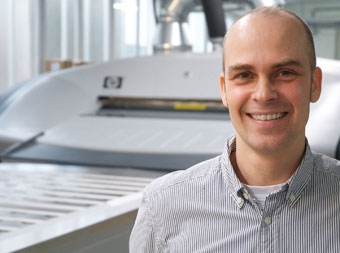KL Druck in Bergisch Gladbach, Germany has been using ONYX RIPs and Thrive workflow solutions for many years and is one of the first companies in the world to upgrade to ONYX 12, launched earlier this month.
This large company is a wide format printing showcase. It offers the full prepress – printing – finishing – installation service to customers worldwide and produces a wide variety of outdoor, transport, POS and event graphics on its extensive line up of UV, dye-sublimation, latex, water-based and solvent digital printers printing to flexible/rigid materials including textiles.
“We want to be using the most up to date printers delivering the best quality and productivity so we tend to invest in a new printer every few months,” says Gunther Fells, Head of Digital Printing at KL Druck. The company invested in Germany’s first HP FP10000 – now upgraded to an FB11000 – which complements 13 other wide format printers, including a HP Latex 3000, a HP Latex 3500, a Vutek GS5000r, a Durst Rhotex322, a new Durst RhotexHS, an HP TJ8600, HP TJ8350, Durst Rho312 and several Epson solvent and HP Latex printers.
The new ONYX 12 software delivers faster RIP performance, a simplified user interface and advanced finishing tools to do more in less time. “Our ONYX Thrive drives 99% of our equipment and upgrading to the new ONYX 12 has had an immediate impact on our productivity and opened up new business opportunities for us,” says Gunther. “It processes 64-bit files 2-3 times faster than before so we can get jobs into production really quickly. This is really important to maximise the power of our high-speed printers such as our new Durst RhotexHS which prints at 300-900 sqm/hr. There is no bottleneck at the RIP. Plus, while we tend to focus on handling print runs of 100+ we can now happily accept print runs of as little as one because we can process files at speed, queue them and print them extremely quickly. This has opened up new markets for us and meets the growing trend for ultra-customisation.”
ONYX 12 features a redesigned user interface which displays a visual, interactive job list enabling operators to easily find jobs, view printer information, and quickly make edits. Complete job information – including thumbnails – is displayed and can be customized to suit each operation’s needs. Live, colour-managed previews display job edits as they happen: users can see exactly where grommets, marks, tiling, crops, cut paths, spot colours and mirroring are placed before processing. This intuitive feature saves time and reduces waste by eliminating guesswork and proof reprints.
The new GUI features have impressed Gunther. “This is much more user friendly and even our new, untrained, operators have found it easy to learn and use,” he says. “It’s very logical and more visual. Instead of file names, we see print previews of the jobs in the queue which makes everything much easier when it comes to fast identification and changing priorities.”











